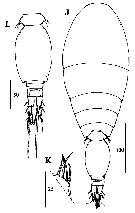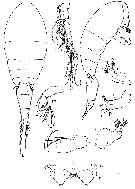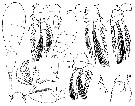|
|
 |
|
Cyclopoida ( Order ) |
|
|
|
Oncaeidae ( Family ) |
|
|
|
Oncaea ( Genus ) |
|
|
| |
Oncaea scottodicarloi Heron & Bradford-Grieve, 1995 (F,M) | |
| | | | | | | Syn.: | Oncaea media : Giesbrecht, 1892 (part., Pl.47: fig.11 only after Heron & Bradford-Grieve, 1995, p.39);
? Oncaea media : Razouls, 1972 (p.101, Annexe: fig.F, non M) | | | | Ref.: | | | Heron & Bradford-Grieve, 1995 (p.39, figs.F,M); Chihara & Murano, 1997 (p.981, Pl.224: F,M); Bradford-Grieve & al., 1999 (p.887, 970, figs.F,M); Böttger-Schnack, 2001 (p.57, 65, figs.F,M, Rem.); Böttger-Schnack & al., 2004 (p.1130, tab.1, Rem.); Böttger-Schnack, 2004 (p.221: Rem.); Avancini & al., 2006 (p.137, Pl. 105, figs.F,M, Rem.); Wi & al., 2009 (p.107, figs.F,M, Rem.); Vives & Shmeleva, 2010 (p.304, figs.F,M, Rem.); Böttger-Schnack & Machida, 2011 (p.111, Table 1, 2, fig.2, 3, DNA sequences, phylogeny); Böttger-Schnack & Schnack, 2013 (p.4: Table 1, Rem.: s.str.-Group); Fuentes-Reinés & Suarez-Morales, 2017 (p.516, figs.F, Rem.) |  issued from : J.H. Wi, Y.H. Yoon & H.Y. Soh in Ocean Sci. J., 2009, 44 (2). [p.109, Fig.10, A-I]. Female (from East Sea of Korea): A, habitus (dorsal); B, A2; C, Md; D, Mx1; E, Mxp; F, endopodite 3 of P1; G, endopodite 3 of P2; H, endopodite 3 of P3; I, endopodite 3 of P4. Scale bars in micrometers.
|
 issued from : J.H. Wi, Y.H. Yoon & H.Y. Soh in Ocean Sci. J., 2009, 44 (2). [p.109, Fig.10, J-L]. Male: J, habitus (dorsal); K, A2; L, urosome. Scale bars in micrometers.
|
 Issued from : G.A. Heron & J.M. Bradford-Grieve in New Zealand Oceanogr. Inst Memoir 104. NIWA, 1995. [p.38, Fig.17, j-r] Female (from Gulf of Naples): j, habitus (lateral) [r]; k, same (dorsal) [r]; l, right A1 [s]; m, right A2 [z]; n, labrum (ventral) [t]; o, right Md [t]; p, right Mx1 [t]; q, right Mx2 [z]; r, left Mxp [z]. Scales in p.13, Fig.2. Letter in brackets.
|
 Issued from : G.A. Heron & J.M. Bradford-Grieve in New Zealand Oceanogr. Inst Memoir 104. NIWA, 1995. [p.40, Fig.18] Female: a, P1 [z]; b, P2 [z]; c, P3 [z]; d, P4 [z]; e, segment of P5 [z]. Male (from Gulf of Naples): f-g, habitus (lateral and dorsal, respectively) [r]; h, posterior of 5th prosomal segment and segment of P5 [s]; i, 3rd segment of left A2 [t]; j, left Mxp [w]; k, P5 [u]. Scales in p.13, Fig.2. Letter in brackets.
|
 Issued from : W. Giesbrecht in Systematik und Faunistik der Pelagischen Copepoden des Golfes von Neapel und der angrenzenden Meeres-Abschnitte. – Fauna Flora Golf. Neapel, 1892. Atlas von 54 Tafeln. [Taf.47, Fig. 11]. As Oncäa media. Female: 11, urosome (dorsal).
|
 Issued from : J.M. Fuentes-Reinés & E. Suarez-Morales in Check List, 2017, 13 (5). [p.515, Figs. 7, 8]. Female (from Rodadero Bay, N Colombia) : 7, urosome (ventral view); 8, genital double-somite showing ventral sclerotization (arrowed). Nota: For the authors, there are some subtle differences in the Colombian Caribbean specimens: 1- length/width ratio of genital double-somite is 1.27 (vs 1.5 from the Red Sea and Gulf of Aden; 1.4 in the Gulf of Naples); the length ratio of the genital double-somite with respect to the rest of urosomites is 2.5 in the Red Sea and Gulf of Aden, 2.3 in the Gulf of naples and 2.2 in the Colombian specimens. These differnces are deemed to be intraspecific variations The shape and location of the scleritization differs among the different species, in O. scottodicarloi, it is a line connected to the genital aperture (see Heron & Bradford-Grieve, 1995, fig.17 K), whereas in both O. media and O. waldemari, sclerotization is absent
| | | | | Compl. Ref.: | | | Ueda & al., 2000 (tab.1); Böttger-Schnack & al., 2001 (p.1029, tab.1, 2); Rezai & al., 2004 (p.490, tab.2, Rem.); Nishibe & Ikeda, 2004 (p.931, Tab. 2, 4, 5); Choi & al., 2005 (p.710: Tab.III); McKinnon & al., 2008 (p.844: Tab.1, p.846: Tab.II, fig.7); Humphrey, 2008 (p.85: Appendix A); Ohtsuka & al., 2008 (p.115, Table 4, 5, Rem.: in Kawasaki and Nagoya Harbors); Nishibe & al., 2009 (p.491, Table 1: seasonal abundance); Böttger-Schnack & Schnack, 2009 (p.131, Table 3, 4); Mazzocchi & Di Capua, 2010 (p.429); Beltrao & al., 2011 (p.47, Table 1, density vs time); DiBacco & al., 2012 (p.483, Table S1, ballast water transport); Dorgham & al., 2012 (p.473, Table 3: abundance %); Tachibana & al., 2013 (p.545, Table 1, seasonal change 2006-2008); Mazzocchi & al., 2014 (p.64, Table 3, 4, occurrence); Benedetti & al., 2016 (p.159, Table I, fig.1, functional characters); Abo-Taleb & Gharib, 2018 (p.139, Table 5, p.145, 149: occurrence %). | | | | NZ: | 9 | | |
|
Distribution map of Oncaea scottodicarloi by geographical zones
|
| | | | | | | | | | Loc: | | | N Colombia (Rodadero Bay), Florida, Bermuda, off Mauritania, Medit. (Alboran Sea, Balearic Basin, Barcelona Harbour, Banyuls, Strait of Sicily, G. of Napoli, N & S Adriatic Sea, Ionian Sea, Lebanon Basin), G. of Aqaba, Hurghada, off Sharm El-Sheikh, Red Sea (N-S), Bab al Mandab Strait, Straits of Malacca, Australia (North West Cape), E Australia, off N New Zealand ( Goat Is.), Japan, Ariake Bay, Tokyo Bay, Kuroshio & Oyashio regions, E Korea, Panama Basin | | | | N: | 24 | | | | Lg.: | | | (681) F: 0,78-0,59; M: 0,6-0,53; (819) F: 0,54-0,61; M: 0,41-0,44; (866) F: 0,64-0,5; M: 0,54-0,38; (1072)* F: 0,630-0,637; M: 0,400-0,408; (1313) F:0,532-0,588;
{F: 0,50-0,78; M: 0,38-0,60}
*: Body length in lateral aspect. | | | | Rem.: | epipelagic & mesopelagic.
This form has been confused with Oncaea media f. minor by various authors, and with O. curta.
For Fuentes-Reinés & Suarez-Morales (2017, p.516, in the Americas, this species can be confused with O. media and O. waldemari, but can be distinguished: 1- the length/width ratio of the genital double-somite about 1.27-1.50 vs 1.7 in O. waldemari and 1.9 in O. media; 2- the length ratio genital double-somite rest of urosomites 2.2-2.5 vs 1.9 in O. walemarii and 3.9 in O. media; 3- the shape and location of the sclerotization differs among these species, it is a line connected to the genital aperture in O. scottodicarloi, whereas in both O. media and O. walderami sclerotization absent.
Male (from Rodadero Bay, N Colombia):
This species was dedicated by the descriptors to our colleague and friend Bruno Scotto di Carlo of the Zoological Station at Naples, tragically deceased at sea in the Tyrrhenian Sea (see in Orbituary in Journal Plankton Research, 12 (2): 245-248, 1990). | | | Last update : 19/06/2023 | |
|
|
 Any use of this site for a publication will be mentioned with the following reference : Any use of this site for a publication will be mentioned with the following reference :
Razouls C., Desreumaux N., Kouwenberg J. and de Bovée F., 2005-2025. - Biodiversity of Marine Planktonic Copepods (morphology, geographical distribution and biological data). Sorbonne University, CNRS. Available at http://copepodes.obs-banyuls.fr/en [Accessed December 13, 2025] © copyright 2005-2025 Sorbonne University, CNRS
|
|
 |
 |








